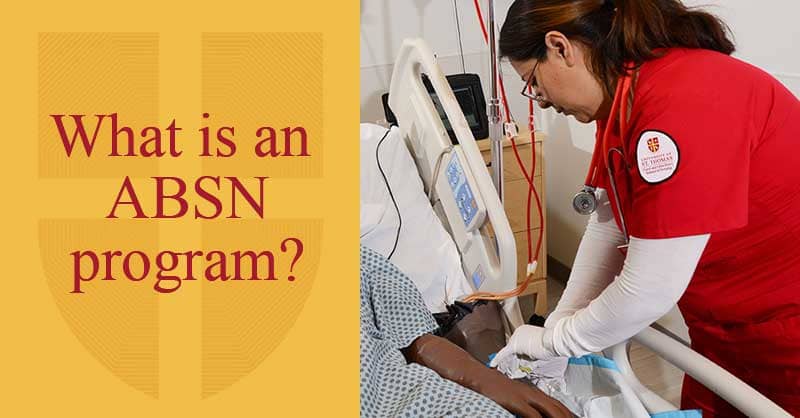How to Get into Nursing School: 6 Steps
Each blog post is dated and contains accurate information as of that date. Certain information may have changed since the blog post publication date. If you would like to confirm the current accuracy of blog information, please visit our ABSN overview page or contact admissions at (855) 830-2713.
If you're thinking about how to get into nursing school, you should know it all begins with finding the right program. Once you've found the nursing school that meets your needs and goals, you'll need to fulfill the requirements to get into nursing school. These can include completing prerequisite courses.

Nursing can be an attractive second career for those looking to make a positive difference in the lives of others. Plus, it offers solid employment prospects, with the U.S. Bureau of Labor Statistics (BLS) projecting a 6% job growth rate for registered nurses (RNs) from 2022 through 2032. Once you’ve decided that nursing is right for you, you’ll probably start wondering how to get into nursing school and how hard is it to get into nursing school.
Getting into a nursing program can be a challenge, as it requires organization, research and dedication. However, you can receive personalized guidance from the friendly admissions counselors at the University of St. Thomas Houston’s Accelerated Bachelor of Science in Nursing (ABSN) program. The ABSN program at UST is designed for career switchers who are eager to enter the nursing workforce as soon as possible. Here, you could graduate with your Bachelor of Science in Nursing (BSN) in as few as 12 months.
Let’s take a closer look at how to increase your chances of getting into nursing school.

What is an ABSN program, exactly? Learn all about it here.
Getting into nursing school is similar to applying for any other type of higher education program. First, you should take some time to reflect upon your intended career path. (Is it really the right choice for you? What specific options are available to you?) Then, you’ll need to meet the requirements to get into nursing school and finalize your application.
Along the way, pay close attention to the guidance offered by your admissions counselor. Your counselor’s mission is to help you increase your chances of getting into nursing school, so following their advice is in your best interests.
1. Determine Your Nursing Career Path
When you picture yourself as a nurse, what do you see? Do you see yourself in an emergency room or trauma center? Or do you see yourself working with infants and children? Deciding what kind of nurse you want to be will help you discover the steps you’ll need to take to reach that goal — and what kind of licenses and specializations you’ll need.
Becoming a practice-ready RN who is equipped with a BSN is a good starting point for working toward nursing specialties, such as oncology, pediatrics, critical care and so on.
2. Find the Right Nursing School

It matters where you choose to earn your nursing degree. Before you begin the admissions process, be clear about your needs when it comes to your education. Doing this can help you decide if our 12-month Accelerated BSN program aligns with your nursing school goals. For example:
- If you’re a career changer with a non-nursing bachelor’s degree, you may be attracted to the fact that our ABSN program lets you earn your BSN in as few as 12 months.
- If you want a quality nursing education, you may like that our ABSN program allows you to gain an education that meets strict academic standards set forth by the Southern Association of Colleges and Schools Commission on Colleges (SACSCOC) and the Commission on Collegiate Nursing Education (CCNE).
Another issue to consider is whether you’re interested in a nursing school that offers a hybrid learning approach. UST’s ABSN program allows you to take nursing theory coursework online, while attending experiential learning components on campus and in area healthcare facilities.

It isn’t always easy to decide where to go to school. Learn more about how to choose a nursing school here.
3. Reach Out to an Admissions Counselor
Once you’ve found the right nursing school for you, your next step is to contact the admissions team. If you’ve chosen to apply to the ABSN program at UST, you’ll work with your dedicated admissions counselor, who will walk you through each step of the process. Your knowledgeable, friendly counselor will help you develop a plan for meeting the admissions requirements, staying on top of deadlines and ensuring that your application is complete.
4. Meet the Requirements to Get into Nursing School
The requirements to get into nursing school vary from one school to the next. Generally, the admissions requirements for ABSN programs can comprise prior college credit or a bachelor’s degree, some prerequisite courses and an entry exam.

As part of the process for getting into the UST ABSN program, you will need to complete and pass (with a score of 80 or higher) the HESI (Health Education System, Inc) exam. This exam assesses your competency in a variety of health science disciplines. To pass, you will need to complete five different exams that assess the mastery of reading comprehension, vocabulary, general knowledge, grammar, math and anatomy and physiology.
5. Complete the Prerequisites
ABSN programs offer a nursing degree on an accelerated timeline. While it’s possible to complete your BSN in as few as 12 months at our nursing school, you may need to complete some prerequisite courses first to prepare for the nursing school curriculum. Your admissions counselor will review your transcripts to determine which, if any, prerequisites you may need.
The nursing-specific prerequisites for the ABSN program at UST are:
- Microbiology
- Algebra or statistics
- Human anatomy and physiology I and II
A course in nutrition is recommended, but not required. Do note the prerequisites must all be completed within five years of applying to UST’s ABSN program, and most require a grade of C or higher (human anatomy and physiology requires a B- or higher).
If you are missing some prerequisites, the good news is you can choose to complete them at UST. This gives you an opportunity to become familiar with our e-learning platform.

6. Ensure Your Application Is Complete and Competitive
Once you’ve fulfilled the admissions requirements to get into nursing school, you’ll be able to submit an official application for enrollment into the ABSN program at UST. On the application, you’ll be asked to indicate your intended start date. At University of St. Thomas, we offer three start dates in May, August and January.
Before submitting your application, it’s a good idea to check in with your admissions counselor. Your counselor can help you ensure your application package contains all the necessary documents — this is one way to increase your chances of getting into nursing school.

Curious to learn more? Check out this blog on how to apply for nursing school.
How Hard Is It to Get Into Nursing School?
When reviewing applications, nursing school admissions staff must consider whether an applicant is likely to do well with the challenging curriculum and hands-on learning experiences. Even when an applicant is well-qualified, nursing schools generally have a limited number of spots available for each cohort. This can make it challenging to get into nursing school.
However, if you have your heart set on becoming a nurse and helping other people, it’s well worth the effort to apply. Plus, if you’ve chosen the ABSN program at UST, you may benefit from the way our nursing school is structured. UST offers three start dates per year, with no waitlist required. It’s part of our commitment to help the U.S. address the nursing shortage.
Ready to Begin Your Nursing Journey?
Now that you have a clearer idea of how to get into nursing school, are you ready to take the first step? At UST, our admissions counselors are committed to your success from day one. If you have the willingness and determination to do what it takes to succeed in the program, we’ll be here to offer the support you need.
Reach out to our admissions team today to chat about accelerating into the nursing profession through UST’s ABSN program.
